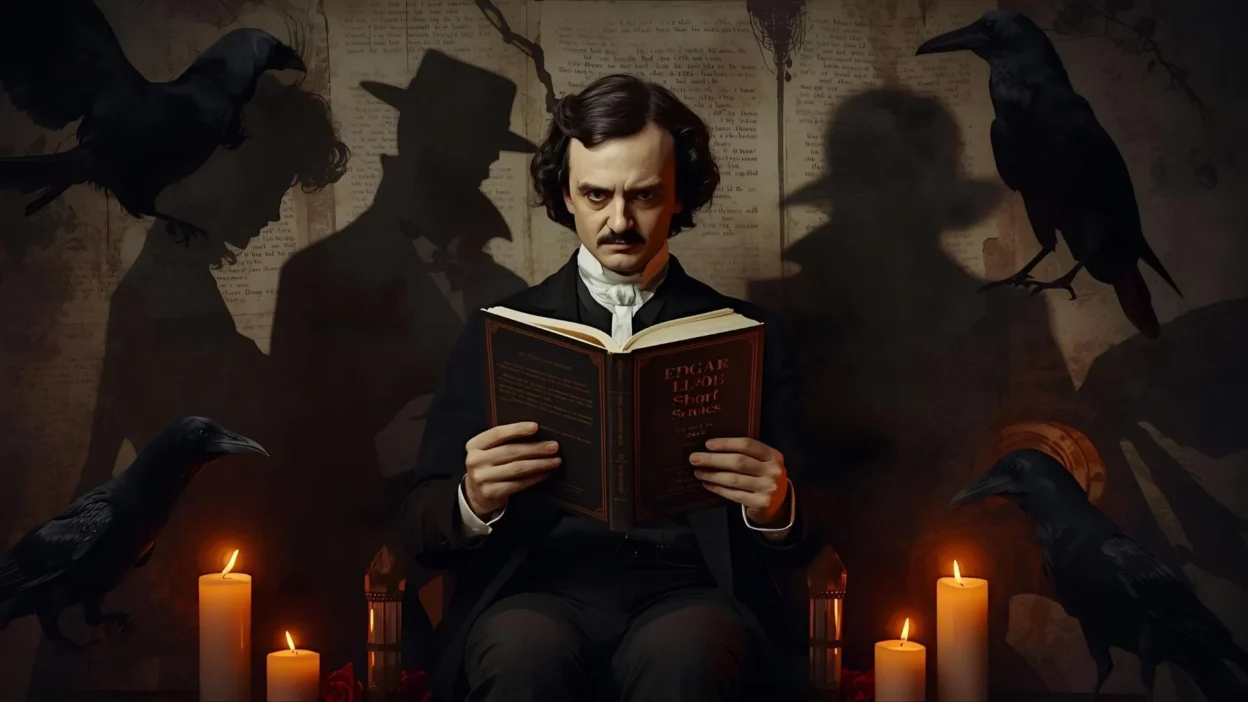The mysterious and macabre world of Edgar Allan Poe short stories continues to fascinate readers, even in 2025. His tales of suspense, horror, and human darkness remain hot, trending, and among the best in gothic literature.
Perfect for adult readers who love eerie twists and psychological tension, these stories capture the chilling brilliance of Poe’s imagination. From haunting guilt to creeping madness, these top Edgar Allan Poe short stories will transport you into a shadowy realm where fear and beauty meet.
Story 1: The Whispering Walls
When Jonathan Harrow inherited the old mansion from his uncle, he expected cobwebs and creaks—but not whispers. Every night, as the moonlight crawled through cracked windows, soft murmurs echoed through the corridors. At first, he thought it was the wind sighing through the broken shutters. But then the whispers began saying his name.
“Jonathan… Jonathan Harrow…”
He followed the sounds one night, candle in hand, down to the cellar. There, he discovered a wall freshly plastered, its color slightly different from the rest. The whispers grew louder, desperate, pleading. His uncle’s diary, found on a dusty shelf, spoke of “a sin buried deep within the house.”
Driven by terror and curiosity, Jonathan broke the plaster. The candle flickered violently. Beneath the wall lay a skeleton, its mouth frozen in silent horror. The whispers stopped. Only his own ragged breathing filled the air.
The next morning, the mansion was quiet. He reported his find to the local constable, but when they returned, the wall was whole again—smooth, spotless, untouched. No sign of the skeleton.
That night, the whispers returned—this time from inside his room.
“Jonathan…”
He ran to the mirror. The reflection of the wall behind him rippled, as though breathing. A faint outline of a face pressed against it from within.
The candle extinguished itself. In the darkness, the walls began to whisper once more.
Moral: Some secrets are better left sealed behind their walls.
Story 2: The Portrait of Elise
In a dimly lit studio, the artist Vincent Delacroix painted his muse, Elise, for weeks. Her beauty haunted him—her pale face, her violet eyes, her faint smile. The painting seemed to come alive under his brush, glowing with eerie realism.
When Elise suddenly fell ill and died, Vincent locked himself away with the unfinished portrait. Days passed. Neighbors heard murmurs from within his studio—two voices, not one.
When the landlord forced open the door, Vincent was found dead before the painting. Elise’s portrait now smiled differently—colder, crueler. Her painted hand, once open, now held a crimson rose.
Moral: Obsession with beauty can paint the path to madness.
Story 3: The Clockmaker’s Heart
In the heart of London, an old clockmaker named Barrow created a masterpiece—a clock that could “beat like a human heart.” Every tick echoed like a pulse, rhythmic and unsettling. He made it for his late wife, to keep her memory alive.
But the clock began to whisper her name. Barrow, sleepless and desperate, spoke back. Soon, he believed she answered. He fed the clock bits of silver and gold, saying it “hungered.”
One night, the constable found the shop door ajar. Inside, the clock ticked louder than ever—beating like a thousand hearts. Barrow was gone, but his spectacles lay before the clock face, fogged from unseen breath.
Moral: When grief tries to bring back the dead, time becomes the cruelest ghost
Story 4: The Raven’s Letter
Eleanor Price lived alone in a seaside cottage where storms raged like unspoken grief. Her husband, a sailor, had been lost to the waves three years ago. Each evening, she lit a candle in the window, hoping for a sign that he still lingered somewhere in the vast black sea.
One stormy night, a knock echoed through the house. When she opened the door, a black raven sat upon the railing, soaked and trembling. Tied to its leg was a damp envelope. In shaky handwriting, her name: “Eleanor.”
Inside was a letter—signed by her husband, Thomas—dated three days prior. It spoke of his love, his regret for leaving, and how he had “found a way to return.” Eleanor wept. She read the letter again and again until she fell asleep beside the candlelight.
At dawn, she awoke to find the raven still perched on the sill, staring with glassy eyes. The candle had burned itself out. She noticed a trail of wet footprints across the floor leading from the door to her bedside.
That evening, she heard another knock. “Thomas?” she whispered, trembling. When she opened the door, the raven was gone—but in its place lay a second envelope. The ink inside was smeared, as though written underwater: “Join me beneath the waves.”
By morning, Eleanor Price had vanished. The sea was calm again, save for a single candle floating atop the waves.
Moral: Some love letters should never be answered.
Story 5: The Chamber Below
When Dr. Miles Crane purchased the abandoned asylum for research, he didn’t believe in the ghost stories. The townsfolk whispered of screams beneath the floorboards, but he dismissed them as superstition.
On his first night inside, he heard faint tapping under the floor. Curious, he followed the sound to a trapdoor hidden beneath an old rug. It led to a narrow staircase descending into the dark. Lantern in hand, he ventured below.
The air grew cold and heavy. The stone walls were etched with names—hundreds of them—scratched by fingernails. At the chamber’s center sat an iron chair, rusted and chained. When he leaned closer, the lantern flickered, revealing a shadow seated there—watching him.
He stumbled back, but the door slammed shut. The chains clattered. From the darkness came whispering voices: “Stay with us, Doctor. Stay forever.”
Days later, the police found the asylum empty. The trapdoor was sealed tight. But on stormy nights, faint tapping echoed from beneath the floorboards once more—slow, steady, waiting.
Moral: Curiosity opens doors that should remain forever closed.
Story 6: The Last Manuscript
Author Harold Finch was celebrated as a genius, his tales of terror rivaling Poe himself. But fame brought pressure. When his publisher demanded another masterpiece, he felt the weight of expectation crush him.
Late one night, as rain lashed his windows, Harold found a black envelope on his desk—no seal, no sender. Inside was a single page, written in elegant cursive: “Write with blood, and you shall never lack inspiration.”
He laughed it off, but the words lingered. Desperate for brilliance, he pricked his finger and let a drop of blood stain the page. Instantly, words began to form on their own, written in crimson ink. The story was magnificent—dark, poetic, alive.
Each night, he offered more blood, and each story grew more haunting. But soon, his hands trembled, his face paled, and his veins thinned. The final night, the maid found him slumped over the desk, drained white as paper. The manuscript was complete—and signed: “Written by Harold Finch and The Ink.”
Moral: True inspiration should never cost one’s soul.
Story 7: The Mirror of Ashcroft Hall
When Lydia moved into Ashcroft Hall, she adored its gothic elegance—especially the grand mirror in the parlor. The locals warned her the mirror had “seen too much,” but she laughed it off.
At night, though, the mirror’s reflection didn’t match reality. Candles flickered in it when none were lit. Sometimes, her reflection smiled when she didn’t.
One evening, Lydia stared at the mirror too long. Her reflection blinked—twice. Then it moved its lips, whispering words she couldn’t hear. Panicked, she covered the mirror with a sheet.
The next morning, the sheet was gone. The mirror gleamed, spotless. In its reflection stood Lydia—only she wasn’t moving. Her real self felt dizzy, faint, cold. When she awoke, she was staring out from inside the glass.
Now, she watches helplessly as another woman moves into Ashcroft Hall. The reflection smiles again, waiting.
Moral: Some reflections show more truth than the soul can bear.
Story 8: The Music Box
Marion loved antique things—especially the delicate, the broken, the forgotten. So when she found a cracked music box in a dusty shop, she couldn’t resist. The shopkeeper warned her, “It only plays once, and never the same again.”
That night, she wound the key and listened. The tune was hauntingly beautiful—melancholy yet sweet. It lulled her into a trance.
The next morning, she awoke to find her apartment slightly different. The wallpaper changed color. The clock read a time that didn’t exist—“13:13.”
She played the box again. The tune shifted, slower, darker. Her reflection in the mirror tilted its head though she hadn’t moved. Each night she played, the world bent further.
When her friend came to visit, Marion was gone. Only the music box remained, playing faintly on the table. Inside, instead of gears, a tiny porcelain figure sat—its face unmistakably Marion’s.
Moral: Some melodies aren’t meant to be heard twice.
Story 9: The Undertaker’s Promise
Arthur Bell was an undertaker who prided himself on precision and dignity. But business was slow, and debt gnawed at him. One night, a tall stranger came to his door with a coffin—and a bag of gold.
“No questions,” the man said. “Bury this tonight, and more gold will follow.”
Arthur hesitated, but greed outweighed fear. He buried the coffin beneath the old oak and sealed the grave.
The next morning, another bag of gold waited on his porch. But the town whispered—someone had exhumed graves overnight, corpses missing.
The stranger returned, pale and smiling. “One more burial,” he whispered, “and your fortune is eternal.”
Arthur refused. That night, he heard knocking from under the floorboards—steady, rhythmic, hollow. By dawn, Arthur Bell had vanished. The undertaker’s shop stood empty, except for a single open coffin… waiting.
Moral: A deal made in darkness always ends in the grave.
Story 10: The Candle in the Crypt
Father Dorian tended an ancient church built over forgotten catacombs. He was faithful, but curious—too curious. Rumors said the crypt held a single candle that never burned out, guarded by silence.
One night, he descended the narrow stairs, carrying only a prayer and a trembling heart. The air thickened, heavy with centuries of decay. At the end of the tunnel, he found it—a single candle, burning bright though no wax melted.
He knelt, whispering a blessing. The flame flickered and spoke—a voice, neither male nor female, whispering secrets of heaven and hell.
Days later, villagers found the church doors locked from within. The candle still burned, but Father Dorian was gone. Only his shadow remained, etched permanently into the stone wall beside it.
Moral: Faith should illuminate, not consume.
Conclusion
These Edgar Allan Poe short stories capture the chilling genius and timeless terror of gothic fiction. For adult readers who crave haunting plots, psychological horror, and poetic darkness, these tales are among the top, best, and most trending 2025 classics inspired by Poe’s world.
Each story blends suspense, emotion, and mystery—proving that even in the modern age, the spirit of Poe’s imagination still burns bright through dark short stories, gothic horror fiction, macabre tales, and psychological thrillers.




